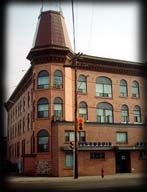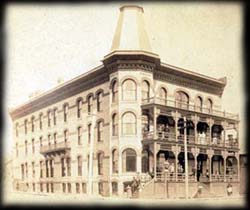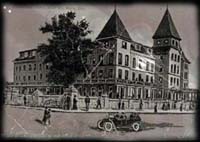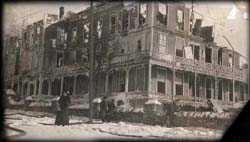|
|
OVERVIEW With the opening of the Canadian Lock system, tourism became an increasingly important aspect of Sault Ste. Marie's economy. Passenger ships plied the Great Lakes bringing travellers from the eastern seaboard and ports along the lakes to the inland seas. Numerous piers dotted the Sault Ste. Marie waterfront to accommodate these ships and, invariably, one would find a hotel as well as other entertainments just a short walk from the pier. Two of the most notable examples of such hotels are the once grandiose Algonquin and International Hotels. The Algonquin Hotel was built in 1888 by William H. Plummer. The architect was J. B. Sweatts and is a good example of Victorian commercial architecture. Financing for the project was arranged through the Bank of Commerce in Toronto. Originally, Mr. Plummer eased his financial burden by selling stock in the Algonquin, but in time he secured complete control of the hotel. The late 1880's were a time of prosperity for the town of Sault Ste. Marie. In 1887, the Canadian Pacific Railway was extended to the town and joined to the U.S. rail system via the International Bridge. This was also the year that Sault Ste. Marie received its town charter. Construction of the Canadian Lock began in 1888. By 1891, about twenty small industries operated in Sault Ste. Marie. The town experienced a rapid population increase from 879 in 1871 to 1621 in 1890. The population base of Sault Ste. Marie also underwent change as the construction projects attracted skilled ethnic workers, notably Italians and Scandinavians. It is in this boom climate that the Algonquin Hotel was built.   William H. Plummer arrived in Sault Ste. Marie in May 1873 at the age of 26. He set up a merchandising business in partnership with Tom Marks. When Marks moved from Sault Ste. Marie, Plummer continued the business under the name of Plummer & Co. By 1888 he was an established businessman and one of the leading citizens of Sault Ste. Marie. His commercial interests centred around his general store at the corner of Pim and Queen, an area which came to be known as "Plummer's Corner" (formerly the site of Phipp's store and dock which Plummer had purchased). Today, W. H. Plummer is remembered as a former mayor of Sault Ste. Marie, having held that post from 1892-1895, 1899-1900 and 1901-1905, a record nine times equalled only by Jack McMeeken between 1917 and 1945. The Plummer Memorial Hospital bears his name after his heirs donated the Plummer estate Lynnhurst, to what was then the Royal Victoria Hospital in 1919. A number of forces contributed to the building of the Algonquin Hotel. In 1888 the International Hotel was built by N. M. Neald and J. C. Meagher at the east corner of Bruce and Queen Streets. It could accommodate 500 guests in 225 rooms, had a dining room capacity of 400, was open all year round, and boasted of all the modern conveniences of 1888. Soon it was referred to as "the grandest house of all." A debate raged in the 1880's and 1890's as to where the centre of town should be located. Plummer argued for Pim and Queen since his interests were based there, while others preferred Bruce and Queen. The westward location of the International threatened to transfer the bulk of the business activity of the community to the west end, away from Plummer's Corner. Although the Pacific Hotel, owned by Jim Miller, operated on lower Pim Street and had a reputation as a leading hotel serving a high class clientele, it was too small to offset the growing influence of the International. Recognizing this Plummer resolved to build the Algonquin. It is interesting to note that the construction of the Post Office in 1904 at the corner of Queen and East fixed the centre of town for many years in the general vicinity of Plummer's Corner. The election of W. H. Plummer to the mayoral office and the success of the Algonquin as a viable competitor to the International had won the day for the Plummer interests. During the years the Algonquin Hotel has played a moderate role in the history of Sault Ste. Marie. The first guest to register was a solicitor named William H. Hearst, who later was elected MPP and became premier of Ontario in 1914. It was here that Francis Hector Clergue stayed in September 1894 after he successfully negotiated the purchase of the municipally owned water power company, thus launching the Clergue industrial empire in Sault Ste. Marie. The dining room of the Algonquin was the site of a luncheon held in honour of H.R.H. Arthur, Duke of Connaught and His Royal Highnesses, the Duchess and Princess Patricia, when they visited the City on August 29, 1912. There is also a reference in the Sault Star to the movie actress Bette Davis staying in the hotel although, no date is mentioned. The hotel was described in the Sault Ste. Marie Michigan News as "a model of convenience, economy of room, perfection of arrangement, good light and adequate ventilation." Today the Algonquin looks basically as it did in 1888. The most obvious changes being the removal of the triple decker wooden porches in 1956 and the conical roof structure advertising the hotel's name. The Algonquin Hotel stands as an important link to the early history of the town of Sault Ste. Marie and its growth into a modern city. It reminds us of the beginnings of the modern tourist trade and of the contributions of William H. Plummer to the city. Architectural Description The exterior dimensions of the hotel are 110 by 48 feet and it stands 50 feet high. The building is of three storeys with a full basement. The exterior exit and storage add ons around the building were not part of the original structure and the brick two storey south elevation has replaced a two storey wood verandah with steps up to the first floor level from Queen Street. Early photographs show the polygonal corner was capped with a truncated tent roof approximately 16 feet above the roof level. The west elevation also was equipped with what appears to be a cast iron balcony at second floor level only bracketed from the wall extending the distance of the three windows in the middle of the wall.
At each floor level, a belt course of brick 12" wide runs horizontally between windows and turns to arch over each window. This rhythm is maintained on all sides of the building and although painted over today, early photographs indicate a polychromatic effect. Both the south elevation cornice and the north wall extend as parapets above the level of the roof which slopes in a plane to the east. The majority of original wood double hung sash windows have been removed at various times and replaced with a prefinished aluminum window. Masonry arches over the windows are all segmental on north west and east elevations but the tower windows and the top floor of the south elevation have Roman Arches and these also originally existed on the south elevation since concealed by the porch addition. The Algonquin Hotel demonstrates both architectural and historical significance in the development of Sault Ste. Marie. Its architectural design has been utilized in other buildings in the city. Of historical significance the site links early commercial and trade activities of the City. The hotel was built by a prominent businessman, W. H. Plummer, who also served as mayor of the city for nine terms between 1892 to 1905, and the hotel is the only surviving member of the large city hotels constructed close to the turn of the century to cater to a young, rapidly expanding industrial centre. The hotel was
designated an Historical site on June 26, 1995. The International Hotel, completed in 1888, was known as the grandest "house" in Sault Ste. Marie. It was furnished with "all known modern improvements and everything up to the standard of the Windsor Hotel in Montreal." The hotel was four storeys high and built "in its own park on the banks of the river directly at the foot of the rapids ", being Queen, Bruce and Bay streets today. The view of the surrounding scenery as it appeared at that time, including the rapids, the canals, the old Hudson's Bay fort and buildings, was magnificent. Two wide balconies ran all around the building, which was 124 by 124 feet. It had 225 rooms with accommodations for 500 guests. There were three large entrances and the main office was at the Bruce Street entrance.
SUMMARY From these early days tourism has grown to be a multi million dollar business and many hotels have replaced those of bygone days. A listing of modern hotels in the City can be found by clicking here. |




